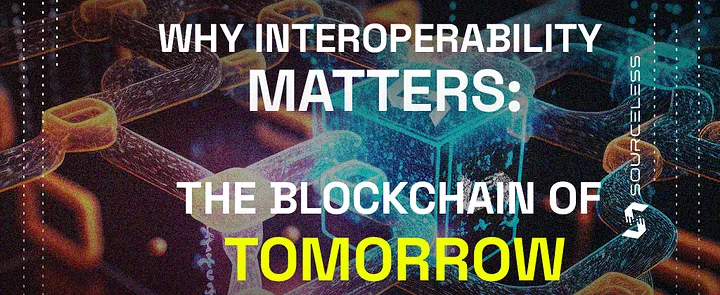Why Interoperability Matters: The Blockchain of Tomorrow

Interoperability in blockchain and Web3 is a term that’s gaining immense traction in today’s digital landscape. Similar to how English enables global communication, interoperability in blockchain allows different networks to interact seamlessly. This article delves into why interoperability is not just a buzzword but a critical component of the future of blockchain technology.
The Importance of Unified Blockchain Ecosystems
Blockchain networks today are akin to isolated islands, with each network hosting unique records and applications. Major blockchains like Bitcoin and Ethereum exemplify this, functioning in siloed ecosystems. This separation, while providing diversity, also leads to vulnerabilities such as weak node networks and potential centralization risks.
The need for interoperability in Web3 is paramount. Just as different transportation systems — like railways, roadways, and airways — need to interconnect to facilitate seamless global travel, blockchain networks require interoperability for efficient digital transactions. Imagine if trains couldn’t operate on tracks laid by a different company, or if cars were confined to roads built by their manufacturer — travel would be inefficient and limited. Similarly, in the blockchain world, networks that can’t interact create digital barriers, hindering the flow of information and transactions.
In the realm of social media, consider a world where Facebook users couldn’t interact with Twitter users. Each platform would exist in a vacuum, significantly limiting social interaction and the sharing of information. This is analogous to the current state of many blockchain networks — operating independently, yet unable to ‘speak’ to each other.
The goal of blockchain interoperability is akin to creating a universal remote control that can operate devices from different manufacturers. Without this interoperability, using multiple devices would require numerous remotes, complicating what should be a simple task. The vision for a unified blockchain ecosystem is to establish this kind of universal ‘remote’ — a standard that allows different blockchains to communicate and transact seamlessly, just as various devices can be controlled effortlessly by a single, well-designed remote.
As we witness more interoperability projects emerging, the vision for a unified blockchain landscape is taking shape. This vision includes integrating with existing systems, enabling transactions across multiple chains, and facilitating the easy switch of underlying platforms for different applications. The most effective approach to achieving this is through the establishment of industry standards and the creation of a “network of networks.” This structure would foster a web of interconnected networks, allowing organizations to transact across multiple solutions and broadening the market for interoperability.
As this “network of networks” model gains traction, the crypto world is beginning to see the emergence of promising blockchain hubs, signaling a significant step towards a more interconnected and robust blockchain ecosystem.
Current Trends and Developments
As of 2023, the global blockchain interoperability market is projected to grow significantly, indicating a surging interest in interconnected blockchain systems. North America is leading in this space, with a focus on industries like healthcare, finance, and supply chain management. In the Asia Pacific region, advancements like the Interledger Protocol are driving significant progress in this domain.
Prominent interoperability protocols like Polkadot, Cosmos, and Wanchain are playing pivotal roles in bridging various blockchain networks and enabling secure asset transfers. Atomic swaps, allowing direct asset exchanges across different blockchains without intermediaries, are enhancing liquidity and efficiency in the ecosystem.
Impact on Industries
Interoperability is set to revolutionize industries such as healthcare, finance, and real estate. In healthcare, it can enable secure data exchange and efficient management of patient records across various networks. In the BFSI sector, interoperability is crucial for secure data exchange, cross-border transactions, and efficient processing of insurance claims.
Smart Contracts and DApps
A significant aspect of interoperability is its ability to bridge smart contracts and decentralized applications (DApps) across different blockchain platforms. This capability fosters innovation, collaboration, and seamless execution of smart contracts, expanding the potential and functionality of DApps.
The Role of Data Oracles
Data oracles are essential in interoperability, providing off-chain data to on-chain smart contracts. They enable interoperable data exchange, enhancing the functionality of decentralized applications and contributing significantly to the ecosystem’s evolution.
SourceLess and the Future of Interoperability
In this evolving landscape, SourceLess is at the forefront, leveraging interoperability to empower users and creators. With its focus on blockchain technology, cryptocurrencies, wNFTs, and DAOs, SourceLess is building an ecosystem that leads to new digital business models and a user-controlled online presence. As we transition to the SourceLess Main Network, the emphasis on interoperability is more pronounced than ever. Acquiring STR Tokens gives users access to unique STR Domains, serving as a passport in the SourceLess World.
Interoperability in blockchain and Web3 is not just a future possibility; it is an ongoing revolution. With projects and platforms like SourceLess pioneering this movement, we are stepping into a new era of digital interaction and innovation, where seamless communication across various blockchain networks is no longer a remote dream but a reality.
Popular
Blockchain revolution








.avif)